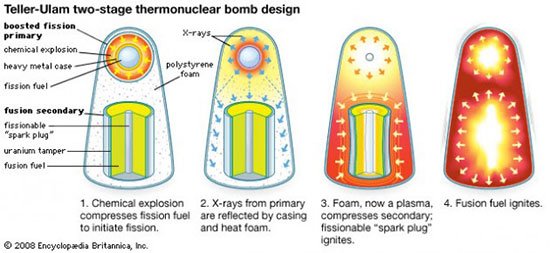Bomb H: How does a hydrogen bomb work?
In 2013, the United Nations General Assembly proclaimed 26 September, International Day for the Total Eradication of Nuclear Weapons. Objective: To raise public awareness of the benefits of disarmament. The hydrogen bomb, or H-bomb, is the most powerful weapon ever imagined by man. The colossal power of its explosion comes from nuclear fusion reactions. Explanations.
The H-bomb, also called the hydrogen bomb or thermonuclear bomb, uses the principle of nuclear fusion to produce an explosion of enormous power. Thus, the first H-bombs developed in the early 1950s reached 10 megatonnes (Mt), equivalent to 10 million tons of TNT. The one designed by the Russians in the early 1960s reached a record 50 Mt, equivalent to 50 million tons of TNT. By comparison, Little Boy, the bomb A dropped on Hiroshima in August 1945, represented the equivalent of the 15,000 kg explosion of TNT, a power of 15 kilotonnes (kt)
Nuclear fusion and H-bomb
If the hydrogen bomb is at this point more powerful than the A bomb, it is because it relies on nuclear fusion reactions. Reactions of the same kind as those which explain why our Sun shines. Nuclei of deuterium and tritium atoms merge to form a helium nucleus. During the reaction, particles are emitted and the core created is lighter than the sum of the two cores involved. This mass difference is converted into a colossal amount of energy.
No bomb H without bomb A
However, in order to initiate nuclear fusion, it is essential to create extreme temperature and pressure conditions. Conditions that are obtained by the nuclear fission reactions that take place during the explosion of a bomb A. An atom of uranium, or plutonium, is broken by projection of a neutron on its nucleus. This fission generates new neutrons which, in turn, will break down the surrounding nuclei and cause a chain reaction. In just a few nanoseconds, the amount of energy needed to trigger a thermonuclear bomb is released.

